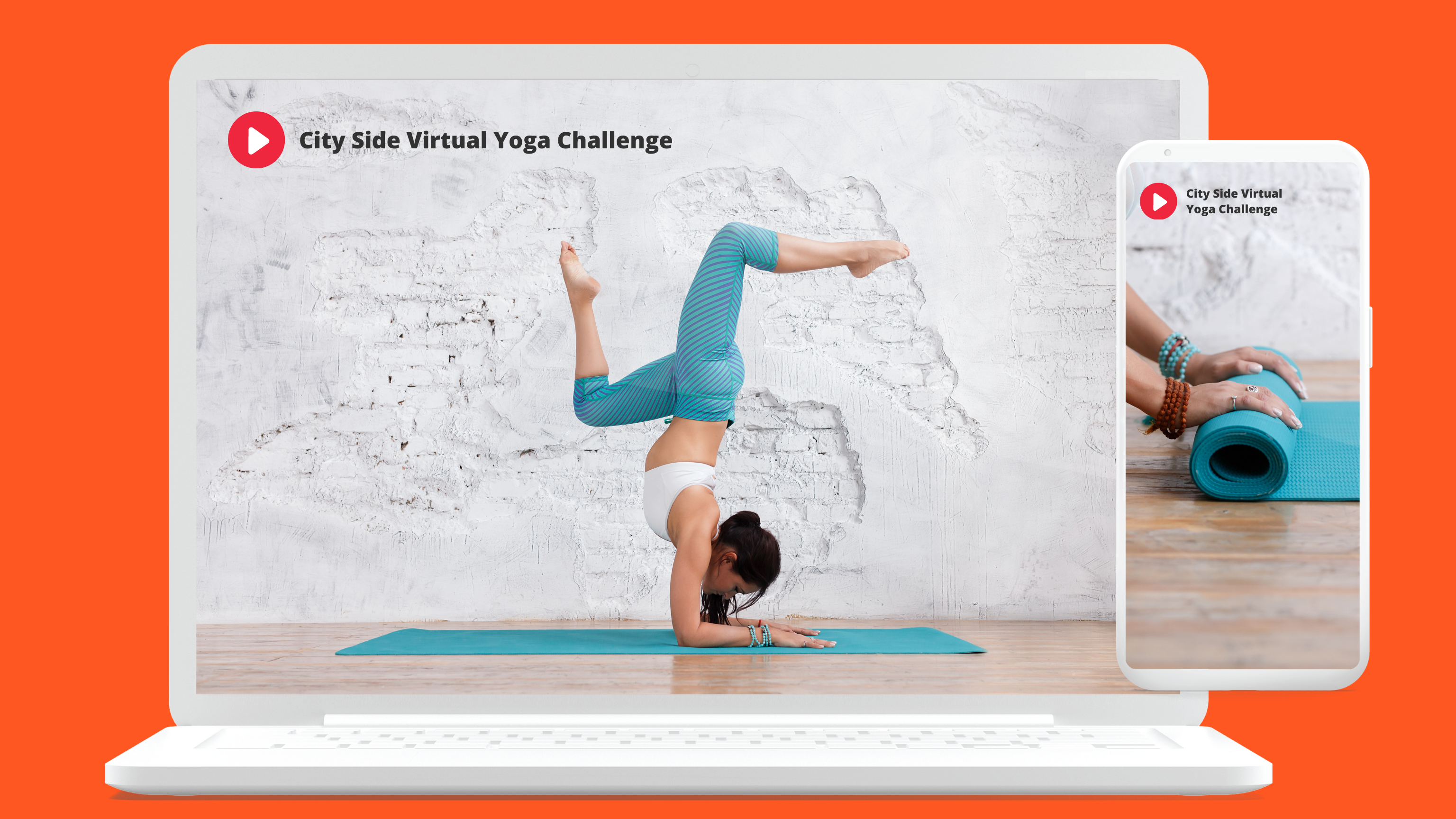Virtual fitness challenges are increasingly popular because they merge in-person experience with the best online tools; they are also highly convenient for people who prefer to stay home to get exercise.
A fitness challenge can benefit both your business and your clientele. It can provide companies with a new revenue stream and participants with inspiration and accountability. But there are other reasons to host a virtual yoga challenge, too. And there are some best practices when it comes to designing and managing your own.
Here’s a guide on how to organize a virtual yoga challenge and create new revenue streams for your event business.
Why host a virtual yoga challenge
In addition to providing a lasting revenue source, virtual fitness challenges can help you meet other objectives.
Client engagement and outreach
Studio owners and yoga instructors can use a yoga challenge to keep old clients engaged and allow new people to sample their style of teaching. Online events can help local businesses create the kind of community that inspires loyalty, bringing fellow enthusiasts together.
Workplace and community health
Offices might run virtual yoga challenges to encourage their employees to invest in wellness by creating teams of healthy and motivated individuals. They can incentivize participation with fun prizes or allow workday workouts. Colleges and universities can do the same.
Fundraising
Virtual challenges also make great fundraisers. Participants can work individually or whole teams can work together towards larger goals. You can charge for participation in the challenge or have participants find sponsors. Sponsors commit to paying a certain amount when yoga milestones are met or when the whole challenge is completed.
Digital and event marketing
Finally, a virtual yoga challenge can play a part in digital marketing efforts. Use the competition to draw attention to your brand. This particular initiative suits businesses in lifestyle and retail industries, as well as fitness.
How to design the challenge
As you get started with your event planning, you’ll need to craft the virtual yoga challenge itself. You want to design a yoga experience that best fits your organization’s goals — whatever they may be.
Identify event success
The first question to answer: What does success look like, and how will you measure it?
To some extent, this will be determined by your general reason for hosting the virtual fitness challenge. But it’s critical to specify clear goals and the metrics by which you’ll measure them.
Fundraising goals might be a straightforward dollar amount, but you could also aim for community buy-in, using the fundraiser to spread awareness of your mission and grow your email lists.
Workplace health-incentive programs could aim for a total number of participants or a total number of hours logged. Or you could instead aim for a smaller number of people to complete a longer challenge.
Studios and gyms could target subscription numbers — either to classes or programs or to marketing channels. Brands might want to aim for a certain level of social media engagement.
Pick your target, and direct the rest of your event organization to meet it.
Identify participant goals
Your goals matter, but so do those of your clientele or organization. What would most inspire them to sign up? What personal goals can you help them meet through your virtual yoga challenge?
Maybe they want to master a certain pose, vary their practice, or develop better habits. Or maybe they want to work on core strength, flexibility, or balance.
Create a yoga experience
With your goal firmly in mind, it’s time to pick your challenge. Let yourself be inspired by established yoga challenges with a history of success, but develop a unique challenge that suits your brand and objectives.
Consider each of the following in your design.
Length
How long should your yoga challenge be? Is this a single-day event — the yoga version of a marathon — or will it last weeks or even months?
Shorter and longer challenges each have their advantages. Shorter challenges may appeal to those just looking to try something new, while longer ones will engage people looking to make a real difference in their bodies or lifestyles.
Event marketers and fundraisers may prefer to run shorter or less intense challenges that require less sustained commitment. On the other hand, longer ones may suit those in the fitness industry. Just make sure there’s enough variation in your design to retain client interest.
Level
One of the great benefits of yoga is its availability to everybody and every type of body. But certain asanas or poses can frustrate or even endanger some practitioners. Likewise, you might bore advanced yogis with a too-rudimentary approach.
Either make challenges scalable for different levels or identify your ideal customer and design appropriate challenges accordingly.
Intensity
Intensity is different from both length and level. How high of a commitment do you want to demand of your participants for the duration of the event?
Do participants merely need to try a different pose each day? Or do they need to put in a full hour multiple times a week?
Competition
Will participants compete against one another directly — to log the most hours or complete the mini-challenges? Or do you want to run the event in participation mode?
You can display superstars on a leaderboard or turn this into a ticker board that shows the latest activity, which can help give each participant confidence as they achieve their goals.
In addition to custom badges, you can award small prizes to leaders or plan a giveaway at some point in the challenge.
Shape the event
Once you know the experience you want to provide, you can start to build the event itself. The Events.com EveryChallenge™ platform comes with all the tools you need to develop your challenge.
Content
What content will you create for the event, and how will you distribute it? Will you be offering live-streaming classes, video content, or daily updates? What do you need to create before the event, and what should be created while it’s ongoing?
Your challenge might require you to produce any or all of the following:
- Tutorials
- Weekly nutrition or workout guides
- Workout calendars
- Live workouts
- Video on demand
- Podcasts
- Guided meditation
Create a full outline of all necessary content and who is going to create it and when.
You also need to plan your distribution. Are you going to use email? Social media? Make updates on the central event page. In addition to giving basic information, you can also use the event page to post videos or announcements.
Events.com also integrates with popular streaming platforms so you can provide live stream links directly on the event page.
Structure
You know what you’re going to challenge participants to accomplish, but how are you going to measure and support their progress?
When some people think of a virtual fitness challenge, they imagine distance trackers and virtual travel, a journey measured in steps, miles, or calories. Yoga challenges demand the same level of commitment but without many of the same metrics.
Do you want to track time logged or calories burned? Or do you want to set intermediate objectives, awarding badges each time a participant hits a certain target? Events.com EveryChallenge™ lets you do either!
You could ask participants to post accountability shots — pictures of poses or videos of sequences — to social media. Just make sure to integrate your accounts.
Price
How does this event tie into your bottom line? Do you envision a monthly subscription or one-time fee? Or do you want to organize a free event to increase company visibility or employee health?
You might also create levels of participation and access or sell branded swag as well as tickets.
Schedule
When will the yoga event start and finish? Where will you divide it into chapters or segments?
You should also decide whether participants will come together at a set time for streamed classes or whether they will complete all challenge activities on their own schedule.
Will they have full access to all content from day one? Or will there be scheduled releases?
Create a detailed event calendar to follow during the event.
How to manage the event
Our event management platform makes it easy to follow through on your design. After setting it up with our easy-to-use interface, you’ll just need to market and monitor the event, sticking to the event calendar you created.
Get the word out! Tell everyone you know and encourage them to spread the word. Momentum breeds momentum, so get your surefire sales to commit early. Use the Events.com Calendar Network to list your event on multiple public calendars. Send announcements and promotions to your email lists. You can even send VIPs more personal invitations and free tickets.
To take your marketing to the next level, try Events.com EveryAd™ — a platform built just for events. Increase participation by selling more tickets to the challenge through Google, Facebook, and Instagram. Use your own social media accounts to promote your challenge, both before and during. Engage your participants. They’re working hard and deserve to be recognized for it.Â
Are you ready to start planning your virtual yoga challenge? Profits and peace are both within reach. You can add a new line of revenue and support all your customers in their own yoga journeys. If that isn’t a win-win, what is?
Request a demo or get started with Events.com EveryChallenge™ today.
‌







